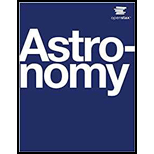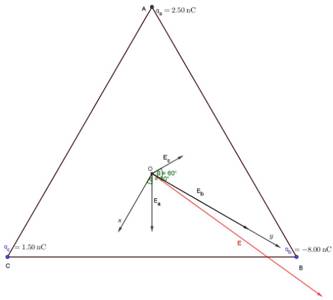
Concept explainers
(a)
The electric field at the center of the triangular configuration of charges.
Answer to Problem 23PE
Explanation of Solution
Given:
Point charges located at the corners of an equilateral triangle 25.0 cm on a side.
Formula used:
Total electric field
Calculation:

Let O be the centroid of our equilateral triangle CBA. Distance from O to any vertex is
Electric field is generally three-dimensional, but since all charges are coplanar with O, z component vanishes, so find x and y components (projections) of
Notice that
Analogously
It's tilted
Conclusion:
Thus,
(b)
The combination of charges that will give a zero-strength electric field at the center of the triangular configuration.
Answer to Problem 23PE
There is no combination of charges other than
Explanation of Solution
Given:
Point charges located at the corners of an equilateral triangle
Calculation:
Suppose
Conclusion:
There is no combination of charges other than
Want to see more full solutions like this?
Chapter 18 Solutions
COLLEGE PHYSICS (OER)
- A Van de Graaff generator is charged so that a proton at its surface accelerates radially outward at 1.52 1012 m/s3. Find (a) the magnitude of the electric force on the proton at that instant and (b) the magnitude and direction of the electric field at the surface of the generator.arrow_forwardA very small ball has a mass of 5.00 103 kg and a charge of 4.00 C. What magnitude electric field directed upward will balance the weight of the ball so that the ball is suspended motionless above the ground? (a) 8.21 102 N/C (b) 1.22 104 N/C (c) 2.00 102 N/C (d) 5.11 106 N/C (e) 3.72 103 N/Carrow_forward(a) Find the total Coulomb force on a charge of 2.00 nC located at x = 4.00 cm in Figure 18.52 (b): given that q = 1,00C . (b) Find the x-position at which the electric field is zero in Figure 18.52 (b).arrow_forward
- Considering Figure 18.46, suppose that qa= qdand qb= qc. First show that q is in static equilibrium. (You may neglect the gravitational force.) Then discuss whether the equilibrium is stable or unstable, noting that this may depend on the signs of the charges and the direction of displacement of q from the center of the square.arrow_forwardAn infinite line of positive charge lies along the y axis, with charge density = 2.00 C/m. A dipole is placed with its center along the x axis at x = 25.0 cm. The dipole consists of two charges 10.0 C separated by 2.00 cm. The axis of the dipole makes an angle of 35.0 with the x axis, and the positive charge is farther from the line of charge than the negative charge. Find the net force exerted on the dipole.arrow_forwardUsing the symmetry of the arrangement, determine the direction of the force on q in the figure below, given that qa=qb=+7.50C and qc = qd = 7.50C. (b) Calculate the magnitude of the force on the charge q, given that the square is 10.0 cm on a side and q = 2.00 C.arrow_forward
- Is it possible for a conducting sphere of radius 0.10 m to hold a charge of 4.0 C in air? The minimum field required to break down air and turn it into a conductor is 3.0 106 N/C.arrow_forwardA proton is located at the origin, and a second proton is located on the x-axis at x = 6.00 fm (1 fm = 10-15 m). (a) Calculate the electric potential energy associated with this configuration. (b) An alpha particle (charge = 2e, mass = 6.64 1027 kg) is now placed at (x, y) = (3.00, 3.00) fm. Calculate the electric potential energy associated with this configuration. (c) Starting with the three-particle system, find the change in electric potential energy if the alpha particle is allowed to escape to infinity while the two protons remain fixed in place. (Throughout, neglect any radiation effects.) (d) Use conservation of energy to calculate the speed of the alpha particle at infinity. (e) If the two protons are released from rest and the alpha panicle remains fixed, calculate the speed of the protons at infinity.arrow_forwardA point charge of 4.00 nC is located at (0, 1.00) m. What is the x component of the electric field due to the point charge at (4.00, 2.00) m? (a) 1.15 N/C (b) 0.864 N/C (c) 1.44 N/C (d) 1.15 N/C (e) 0.864 N/Carrow_forward
- 48. Find the total Coulomb force on a charge q in Figure 18.53, given that q = 1.00 C, qa=2.00 C, qb=-3.00 C, qc,=-4.00C, and qd= + 1.00 C. The square is 50.0 cm on a side.arrow_forwardReview. A particle with a charge of 60.0 nC is placed at the center of a nonconducting spherical shell of inner radius 20.0 cm and outer radius 25.0 cm. The spherical shell carries charge with a uniform density of 1.33 C/m3. A proton moves in a circular orbit just outside the spherical shell. Calculate the speed of the proton.arrow_forward(a) Find the electric field at the center of the triangular configuration of charges in Figure 18-54., given that qa=+ 2.50 nC, qb=-8.00 nC, and qc=+ 1.50 nC. (b) Is there any combination of charges, other than qa= qb=qc,that will produce a zero strength electric field at the center of the triangular configuration?arrow_forward
 College PhysicsPhysicsISBN:9781938168000Author:Paul Peter Urone, Roger HinrichsPublisher:OpenStax College
College PhysicsPhysicsISBN:9781938168000Author:Paul Peter Urone, Roger HinrichsPublisher:OpenStax College Physics for Scientists and Engineers: Foundations...PhysicsISBN:9781133939146Author:Katz, Debora M.Publisher:Cengage Learning
Physics for Scientists and Engineers: Foundations...PhysicsISBN:9781133939146Author:Katz, Debora M.Publisher:Cengage Learning College PhysicsPhysicsISBN:9781305952300Author:Raymond A. Serway, Chris VuillePublisher:Cengage Learning
College PhysicsPhysicsISBN:9781305952300Author:Raymond A. Serway, Chris VuillePublisher:Cengage Learning Physics for Scientists and Engineers with Modern ...PhysicsISBN:9781337553292Author:Raymond A. Serway, John W. JewettPublisher:Cengage Learning
Physics for Scientists and Engineers with Modern ...PhysicsISBN:9781337553292Author:Raymond A. Serway, John W. JewettPublisher:Cengage Learning Physics for Scientists and EngineersPhysicsISBN:9781337553278Author:Raymond A. Serway, John W. JewettPublisher:Cengage Learning
Physics for Scientists and EngineersPhysicsISBN:9781337553278Author:Raymond A. Serway, John W. JewettPublisher:Cengage Learning Principles of Physics: A Calculus-Based TextPhysicsISBN:9781133104261Author:Raymond A. Serway, John W. JewettPublisher:Cengage Learning
Principles of Physics: A Calculus-Based TextPhysicsISBN:9781133104261Author:Raymond A. Serway, John W. JewettPublisher:Cengage Learning





